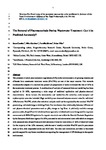The removal of pharmaceuticals during wastewater treatment: Can it be predicted accurately?
| dc.contributor.author | Comber, Sean | |
| dc.contributor.author | Gardner, M | |
| dc.contributor.author | Sörme, P | |
| dc.contributor.author | Ellor, B | |
| dc.date.accessioned | 2019-05-15T12:11:06Z | |
| dc.date.available | 2019-05-15T12:11:06Z | |
| dc.date.issued | 2019-08-01 | |
| dc.identifier.issn | 0048-9697 | |
| dc.identifier.issn | 1879-1026 | |
| dc.identifier.uri | http://hdl.handle.net/10026.1/13979 | |
| dc.description.abstract |
The presence of active pharmaceutical ingredients (APIs) in the environment is of growing concern and effluents from wastewater treatment works (WwTWs) are one of the major sources. This research combines the outputs of a multimillion pound UK program of work to evaluate the fate of APIs in the wastewater treatment process. A combination of analysis of measured data and modelling has been applied to 18 APIs, representing a wide range of medicinal application and physico-chemical characteristics. Some isomers (for atorvastatin) and metabolites (for sertraline, carbamazepine and erythromycin) were also included. High variability was observed between removal rates for individual APIs between WwTW, which after statistical analysis could not be explained by the nominal WwTW process (e.g. activated sludge or trickling filter). Nor was there a clear relationship between API removal and physico-chemical parameters such as pKa, charge or log Kow. A publically available sewage process model, SimpleTreat 4.0 which has been rigorously validated and is now being used for exposure assessment with REACH legislation for organic chemicals and within the Biocidal Products Regulation by the European Medicines Agency for APIs, was used to estimate removal rates with which to compare with measured data. SimpleTreat provided estimates of removal rates within ±30% of observed values for the majority of the APIs measured, with the use of readily available WwTW specific parameters such as flow, total suspended solids and BOD data. The data and correlations provided in this study provide support for any future considerations regarding the management of API discharge to the aquatic environment. | |
| dc.format.extent | 222-230 | |
| dc.format.medium | Print-Electronic | |
| dc.language | en | |
| dc.language.iso | en | |
| dc.publisher | Elsevier | |
| dc.rights | Attribution-NonCommercial-ShareAlike 4.0 International | |
| dc.rights | Attribution-NonCommercial-ShareAlike 4.0 International | |
| dc.rights | Attribution-NonCommercial-ShareAlike 4.0 International | |
| dc.rights | Attribution-NonCommercial-ShareAlike 4.0 International | |
| dc.rights | Attribution-NonCommercial-ShareAlike 4.0 International | |
| dc.rights | Attribution-NonCommercial-ShareAlike 4.0 International | |
| dc.rights | Attribution-NonCommercial-ShareAlike 4.0 International | |
| dc.rights.uri | http://creativecommons.org/licenses/by-nc-sa/4.0/ | |
| dc.rights.uri | http://creativecommons.org/licenses/by-nc-sa/4.0/ | |
| dc.rights.uri | http://creativecommons.org/licenses/by-nc-sa/4.0/ | |
| dc.rights.uri | http://creativecommons.org/licenses/by-nc-sa/4.0/ | |
| dc.rights.uri | http://creativecommons.org/licenses/by-nc-sa/4.0/ | |
| dc.rights.uri | http://creativecommons.org/licenses/by-nc-sa/4.0/ | |
| dc.rights.uri | http://creativecommons.org/licenses/by-nc-sa/4.0/ | |
| dc.subject | Pharmaceuticals | |
| dc.subject | Modelling | |
| dc.subject | Removal efficiency | |
| dc.subject | Wastewater treatment | |
| dc.subject | Activated sludge | |
| dc.subject | Trickling filter | |
| dc.title | The removal of pharmaceuticals during wastewater treatment: Can it be predicted accurately? | |
| dc.type | journal-article | |
| dc.type | Journal Article | |
| plymouth.author-url | https://www.webofscience.com/api/gateway?GWVersion=2&SrcApp=PARTNER_APP&SrcAuth=LinksAMR&KeyUT=WOS:000468188300022&DestLinkType=FullRecord&DestApp=ALL_WOS&UsrCustomerID=11bb513d99f797142bcfeffcc58ea008 | |
| plymouth.volume | 676 | |
| plymouth.publication-status | Published | |
| plymouth.journal | Science of the Total Environment | |
| dc.identifier.doi | 10.1016/j.scitotenv.2019.04.113 | |
| plymouth.organisational-group | /Plymouth | |
| plymouth.organisational-group | /Plymouth/Faculty of Science and Engineering | |
| plymouth.organisational-group | /Plymouth/Faculty of Science and Engineering/School of Geography, Earth and Environmental Sciences | |
| plymouth.organisational-group | /Plymouth/REF 2021 Researchers by UoA | |
| plymouth.organisational-group | /Plymouth/REF 2021 Researchers by UoA/UoA06 Agriculture, Veterinary and Food Science | |
| plymouth.organisational-group | /Plymouth/Research Groups | |
| plymouth.organisational-group | /Plymouth/Research Groups/BEACh | |
| plymouth.organisational-group | /Plymouth/Research Groups/Marine Institute | |
| plymouth.organisational-group | /Plymouth/Users by role | |
| plymouth.organisational-group | /Plymouth/Users by role/Academics | |
| dc.publisher.place | Netherlands | |
| dcterms.dateAccepted | 2019-04-08 | |
| dc.rights.embargodate | 2020-4-9 | |
| dc.identifier.eissn | 1879-1026 | |
| dc.rights.embargoperiod | Not known | |
| rioxxterms.versionofrecord | 10.1016/j.scitotenv.2019.04.113 | |
| rioxxterms.licenseref.uri | http://creativecommons.org/licenses/by-nc-sa/4.0/ | |
| rioxxterms.licenseref.startdate | 2019-08-01 | |
| rioxxterms.type | Journal Article/Review |



